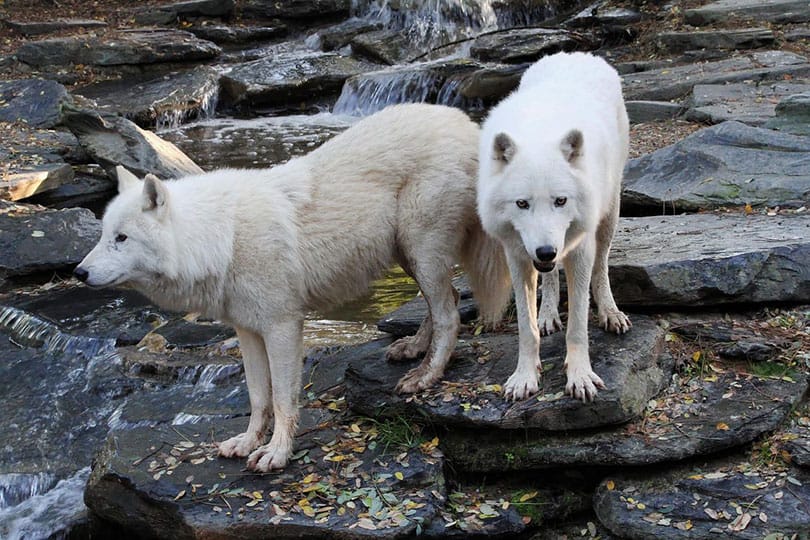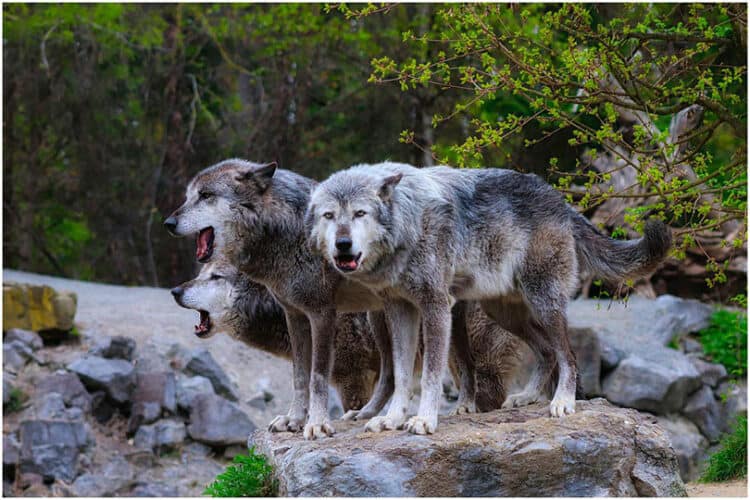Domesticated dogs and wild wolves are similar in many ways. These two animals are evolutionary cousins that share some behavioral and biological traits. In fact, dogs and wolves are so closely related that they share 99.9% of their DNA.
A fact that’s surprising to many is that the dog, or Canis familiaris, is a direct descendant of the gray wolf, or Canis lupus. This helps explain why dogs and wolves even look alike in some cases. However, generally speaking, wolves are bigger than dogs and differ physically in other ways.
Why It’s Not Easy to Compare the Size of Wolves vs. Dogs
As you probably know, dogs come in a wide range of breeds and sizes, from tiny Chihuahuas weighing just a few pounds to large Great Danes that weigh much more.
There are also several species of wolves in the world, and they too come in varying sizes. For example, the smallest wolf in the world, the Arabian wolf, only weighs around 45 pounds, while the gray wolf, which is the largest, weighs more than double that amount.
Because there are so many size variations of both dogs and wolves, it’s not a simple task to say exactly how big wolves are compared to dogs. However, we can break down some facts about both animals while focusing on one wolf species in particular, which is the gray wolf and the most common wolf found in the US. When it comes to size, the physical makeup of the gray wolf is impressive. The typical adult male gray wolf is over 5 feet long, including its bushy tail, and the animal can weigh well over 140 pounds.
If you compare that size to the biggest dog you’ve ever seen, like a large Great Dane, the gray wolf wins because a Great Dane weighs an average of 100–120 pounds with a body length of about 3.5 feet.

Other Ways Wolves Differ Physically From Dogs
Both wolves and dogs have 42 teeth, but wolves have larger teeth and bigger skulls and jaws. Their skulls and jaws are larger because these wild animals need lots of power to bite and break things, like animal bones, compared to domesticated dogs that are fed by humans.Wolves also have pointed ears and long sickle-like tails, while many dog breeds have evolved to have floppy ears or short tails that curl. When it comes to the paws of these two animals, wolves have much larger feet, allowing them to spring off their toes when running great distances while giving them a good grip on the terrain.
The eye color differs between wolves and dogs, too. While most dogs have brown or blue eyes, wolves have yellow eyes. Another physical difference between these two animals is that wolves have narrower chests and longer legs, allowing them to run very fast. The domestic dog, on the other hand, tends to have a wide, stocky chest and shorter legs.
Some Dogs Look Very Much Like Wolves
Some dog breeds look like wolves when it comes to their overall size, build, and coloring. One such breed is the Finnish Tamaskan dog. Malamutes are also wolf-like in appearance, as are Canadian Eskimo dogs.
Of all the dog breeds that look like wolves, many people believe that the American Alsatian is the breed that most resembles a wolf. This is a new breed developed to look like the large, prehistoric dire wolf that lived thousands of years ago in the Americas.
Not only does an American Alsatian have large feet like a wolf, but it also has a large head, a long body, and weighs in at around 100 pounds, making it one big, wolf-like dog!
Conclusion
Because there are many sizes and types of both wolves and dogs, it’s not easy to say exactly how big wolves are compared to dogs. Generally speaking, however, wolves tend to be bigger and more athletic than dogs. A sure-fire way to tell a wolf from a dog is to look at the eye color. Wolves have yellow eyes while dogs have brown or white eyes.
Featured Image Credit: Pixabay
















